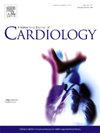合成代谢雄激素类固醇对抗阻训练运动员心脏结构和功能的影响:系统回顾和荟萃分析。
IF 3.2
2区 医学
Q2 CARDIAC & CARDIOVASCULAR SYSTEMS
引用次数: 0
摘要
背景:合成代谢雄激素类固醇(AAS)广泛用于抗阻训练运动员,但其对心脏结构和功能的影响尚不清楚。目的:应用超声心动图评价AAS对心脏结构和功能的影响。方法:我们采用随机效应模型和review Manager 5.4.1进行了系统回顾和meta分析,以评估AAS对运动员超声心动图参数的影响。结果:我们纳入了35项研究,涉及2000名男性个体(834名使用AAS进行阻力训练的运动员vs 754名未使用AAS进行阻力训练的运动员vs 412名久坐不动的对照组;平均年龄32岁 岁)。与未使用AAS的运动员相比,AAS使用者与左室(LV)射血分数降低相关(MD -2.25 %;95 % CI -3.41至-1.09;p )结论:在运动员中,与未使用AAS的运动员相比,AAS与左室射血分数和GLS显著降低相关,同时室间隔和后壁厚度、左室质量和舒张末期直径增加相关。这些研究结果表明,在AAS使用者中存在不良的心脏重构,突出了运动员使用类固醇对心血管的潜在有害影响。本文章由计算机程序翻译,如有差异,请以英文原文为准。

Anabolic-androgenic steroids on cardiac structure and function in resistance-trained athletes: A systematic review and meta-analysis
Background
Anabolic-androgenic steroids (AAS) are widely used by resistance-trained athletes, but their effects on cardiac structure and function remain uncertain.
Objective
To assess the impact of AAS on cardiac structure and function using echocardiography.
Methods
We performed a systematic review and meta-analysis to assess the effects of AAS on echocardiographic parameters in athletes, using a random-effects model and Review Manager 5.4.1.
Results
We included 35 studies with 2000 male individuals (834 resistance-trained athletes using AAS vs 754 resistance-trained non-users vs 412 sedentary controls; mean age 32 years). Compared with non-users of AAS, AAS users was associated with a decrease in left ventricular (LV) ejection fraction (MD -2.25 %; 95 % CI -3.41 to −1.09; p < 0.01), and global longitudinal strain (GLS) (MD 3.34 %; 95 % CI 2.93 to 3.76; p < 0.01). Athletes who used AAS also had an increased septal wall thickness (MD 1.24 mm; 95 % CI 0.79 to 1.69; p < 0.01), posterior wall thickness (MD 1.09 mm; 95 % CI 0.70 to 1.48; p < 0.01) and LV mass (MD 13.29 g; 95 % CI 6.25 to 20.33; p < 0.01). LV end-diastolic diameter was also higher among AAS users (MD 1.09 mm; 95 % CI 0.44 to 1.73; p < 0.01).
Conclusion
Among athletes, AAS was associated with a significant decrease in LV ejection fraction and GLS, alongside with increased septal and posterior wall thickness, LV mass, and end-diastolic diameter compared with athletes who do not use AAS. These findings suggest adverse cardiac remodeling in AAS users, highlighting the potential harmful cardiovascular effects of steroid use in athletes.
求助全文
通过发布文献求助,成功后即可免费获取论文全文。
去求助
来源期刊

International journal of cardiology
医学-心血管系统
CiteScore
6.80
自引率
5.70%
发文量
758
审稿时长
44 days
期刊介绍:
The International Journal of Cardiology is devoted to cardiology in the broadest sense. Both basic research and clinical papers can be submitted. The journal serves the interest of both practicing clinicians and researchers.
In addition to original papers, we are launching a range of new manuscript types, including Consensus and Position Papers, Systematic Reviews, Meta-analyses, and Short communications. Case reports are no longer acceptable. Controversial techniques, issues on health policy and social medicine are discussed and serve as useful tools for encouraging debate.
 求助内容:
求助内容: 应助结果提醒方式:
应助结果提醒方式:


